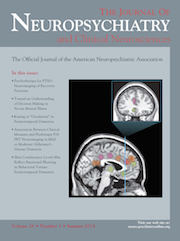Capgras Syndrome During the Course of Parkinson Disease Dementia
To the Editor: DMS are very rarely dementia-related with Parkinson’s disease (PD).1–3 Our first patient, a 69-year-old man, developed resting tremor and bradykinesia on his left arm at the age of 56 years. Neurological examination revealed resting tremor (left>right), bilateral bradykinesia, and rigidity. He was treated with levodopa for 2 years, and then consulted with the PD surgery committee for progressive increase in tremor and motor complications of levodopa. The patient had a successful right pallidotomy operation. Following surgery, he developed rapid cognitive impairment and visual hallucinations. He recognized his family members with their correct names but felt that they were strangers looking very similar to his relatives. Soon after, he claimed that his wife and children were not ‘in reality’ who they were but some other people who just looked like his wife and children. He claimed that he was kept in a location other than his house that resembled his house.
The second patient, a 77-year-old man, had resting tremor and bradykinesia prominent in his right arm for 5 years. A history of REM sleep behavior disorder for 6 years prior to the onset of parkinsonian symptoms was provided by his wife. Neurological examination revealed resting tremor (right>left), bilateral bradykinesia, rigidity and hypophonic speech. He was diagnosed as Parkinson’s disease and given levodopa, pribedil and pramipexole treatment with substantial benefit. After he developed visual hallucinations, dopamine agonists were discontinued and the dose of levodopa was increased. About 2 years later, he developed progressive cognitive impairment. For the last 1 year, he started to have delusional ideas. The patient’s wife stated that he did not recognize their house but kept saying that he wanted to go home. He did not recognize his wife, but conveyed that there was a woman who looks like her, maybe her sister, who wanted to marry him for 40 years. He dismissed his wife from their home, saying that his real wife would come to the house soon. At times he recognized his wife and told her that there had been someone in their home who looked like her.
These patients were diagnosed as PD dementia with DMS as Capgras syndrome. The presence of levodopa-responsiveness, later-developed fluctuating confusion, and cognitive impairment associated with psychotic symptoms supported the diagnosis of dementia-related PD.4 Misidentifications are best explained as primary delusions rather than being related solely to cognitive impairment. The pattern of cognitive impairment in dementia-related PD patients with DMS suggests a greater dysfunction of temporal cortex in addition to frontal lobe dysfunction in dementia-related PD patients.5 Although excess dopaminergic stimulation of the mesolimbic system may account for visual hallucinations and other psychotic symptoms in PD patients, it may not be sufficient to cause delusional misidentification, but additional frontal lobe impairment is required, which produces a disturbance in judgment, self-awareness, and relatedness to elements in the environment such as persons, places, and objects.1–3 Although other neurodegenerative diseases are known to be associated with delusional misidentification syndromes, this case report suggests that delusions of misidentification could also be observed in PD dementia.
1 : Delusional misidentification in association with parkinsonism. J Neuropsychiatry Clin Neurosci 1998; 10:194–198Link, Google Scholar
2 : Dopamine deficiency may lead to capgras syndrome in Parkinson's disease with dementia. J Neuropsychiatry Clin Neurosci 2010; 22:352i.e14–352.e15Crossref, Google Scholar
3 : Combined delusional misidentification syndrome in a patient with Parkinson's disease. J Neuropsychiatry Clin Neurosci 2012; 24:E3–E4Link, Google Scholar
4 : Clinical diagnostic criteria for dementia associated with Parkinson disease. Mov Disord 2007; 22:1689–1707Crossref, Medline, Google Scholar
5 : What’s in a name: voxel-based morphometric analyses of MRI and naming difficulty in Alzheimer’s disease, frontotemporal dementia and corticobasal degeneration. Brain 2004; 127:628–649Crossref, Medline, Google Scholar



